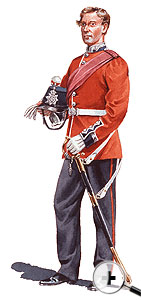Guildford Barracks
End of the Cavalry Barracks
In 1815 the Napoleonic Wars came to an end and by 1818 the troops had returned from France, the Militia had been disbanded, the Army was reduced and the Guildford Barracks, including the Friary House, were pulled down. The demolition of the buildings after only 22 years of use suggests that they were temporary erections and may explain why Russell in 1801, though speaking of a cavalry barracks at the Friary gives no descriptions of the new buildings though in the 1845 edition they are described as 'extensive'.
On 7th December 1818 the 'Ordnance property at Guildford called the Priory Estate, formerly used as a Barrack' was leased by the Barrack Board to Mr William Elkins, a brewer with a wharf on the river just north of the Guildford Bridge for 21 years. The lease was not to be terminated before Christmas 1839, unless the Government wanted the estate for its own use. The ground covered about 13 acres, and the only buildings left were the Guard House at the south-west comer, in North Street, a store near the river and a wagon shed in the north-west comer.
 |
| Officer c1867. |
Mr Elkins allowed part of the ground to be used as a cricket field and the store became for a short time a girls' school. In Smith's 'Rambles Round Guildford', published in 1828, is a list of schools including 'The Lancastrian School Society. At present there is only one school of this description in the town; it is for girls only and is principally supported by members of the Society of Friends. A part of the store rooms of the late Barracks was converted into a school house some years since and is still employed for the same purpose. It stands near the cricket ground upon the eastern bank of the river'. In 1840, however, when the estate was sold, this store room was described as being used for a variety of other purposes, for example, in 1828 the Corporation paid Mr Elkins 8 pounds for permission to hold the November fair on his ground; it has also been said that at the time of the Com Laws agitation (the Anti-Com Law League was founded in 1838), Cobden and Bright addressed crowds while standing on wagons in this ground, and it was also at times a pitching place for circuses.
In 1839 when Mr Elkins' lease expired the Barrack department carefully considered whether to retain the estate in case of need in a future war. The Barrack Master General knew of no better station for a Cavalry Regiment, in view of its position between London and Portsmouth and thought that if the estate were to be sold it should only be for a very high price. It was decided to advertise, and in January 1840 the War Office accepted the sum of 4,500 from Messrs Ladbrooke & Co., on behalf of Messrs Palmer and Nicholls, and some of the estate was quickly broken up and sold as building lots.
So the north-west area of Guildford, which for seven centuries had been in turn a Friary garden, a private park, a barrack field and a cricket ground, was split up and became by degrees available to Victorian builders, who made of it the somewhat dismal commercial area we now see.
Related
